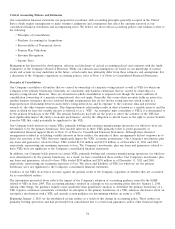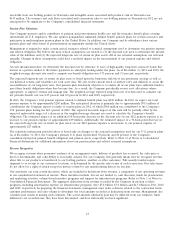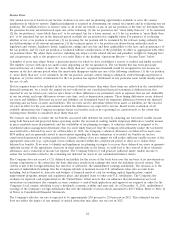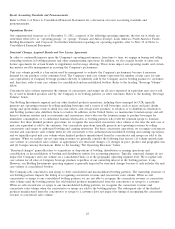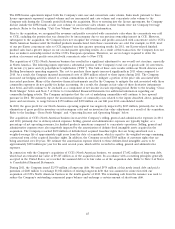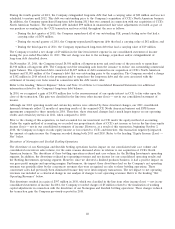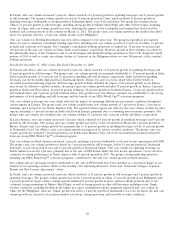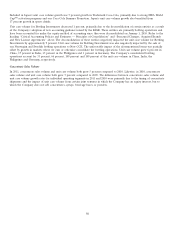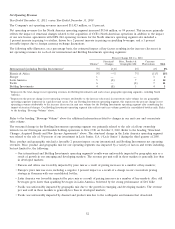Coca Cola 2011 Annual Report Download - page 45
Download and view the complete annual report
Please find page 45 of the 2011 Coca Cola annual report below. You can navigate through the pages in the report by either clicking on the pages listed below, or by using the keyword search tool below to find specific information within the annual report.Recent Accounting Standards and Pronouncements
Refer to Note 1 of Notes to Consolidated Financial Statements for a discussion of recent accounting standards and
pronouncements.
Operations Review
Our organizational structure as of December 31, 2011, consisted of the following operating segments, the first six of which are
sometimes referred to as ‘‘operating groups’’ or ‘‘groups’’: Eurasia and Africa; Europe; Latin America; North America; Pacific;
Bottling Investments; and Corporate. For further information regarding our operating segments, refer to Note 19 of Notes to
Consolidated Financial Statements.
Structural Changes, Acquired Brands and New License Agreements
In order to continually improve upon the Company’s operating performance, from time to time, we engage in buying and selling
ownership interests in bottling partners and other manufacturing operations. In addition, we also acquire brands or enter into
license agreements for certain brands to supplement our beverage offerings. These items impact our operating results and certain
key metrics used by management in assessing the Company’s performance.
Unit case volume growth is a key metric used by management to evaluate the Company’s performance because it measures
demand for our products at the consumer level. The Company’s unit case volume represents the number of unit cases (or unit
case equivalents) of Company beverage products directly or indirectly sold by the Company and its bottling partners to customers
and, therefore, reflects unit case volume for consolidated and unconsolidated bottlers. Refer to the heading ‘‘Beverage Volume’’
below.
Concentrate sales volume represents the amount of concentrates and syrups (in all cases expressed in equivalent unit cases) sold
by, or used in finished products sold by, the Company to its bottling partners or other customers. Refer to the heading ‘‘Beverage
Volume’’ below.
Our Bottling Investments segment and our other finished products operations, including those managed by CCR, typically
generate net operating revenues by selling sparkling beverages and a variety of still beverages, such as juices and juice drinks,
energy and sports drinks, ready-to-drink teas and coffees, and certain water products, to retailers or to distributors, wholesalers
and bottling partners who distribute them to retailers. In addition, in the United States, we manufacture fountain syrups and sell
them to fountain retailers such as restaurants and convenience stores who use the fountain syrups to produce beverages for
immediate consumption, or to authorized fountain wholesalers or bottling partners who resell the fountain syrups to fountain
retailers. For these finished products operations, we recognize the associated concentrate sales volume at the time the unit case or
unit case equivalent is sold to the customer. Our concentrate operations typically generate net operating revenues by selling
concentrates and syrups to authorized bottling and canning operations. For these concentrate operations, we recognize concentrate
revenue and concentrate sales volume when we sell concentrate to the authorized unconsolidated bottling and canning operations,
and we typically report unit case volume when finished products manufactured from the concentrates and syrups are sold to the
customer. When we analyze our net operating revenues we generally consider the following four factors: (1) volume growth (unit
case volume or concentrate sales volume, as appropriate), (2) structural changes, (3) changes in price, product and geographic mix
and (4) foreign currency fluctuations. Refer to the heading ‘‘Net Operating Revenues’’ below.
‘‘Structural changes’’ generally refers to acquisitions or dispositions of bottling, distribution or canning operations and
consolidation or deconsolidation of bottling and distribution entities for accounting purposes. Typically, structural changes do not
impact the Company’s unit case volume on a consolidated basis or at the geographic operating segment level. We recognize unit
case volume for all sales of Company beverage products regardless of our ownership interest in the bottling partner, if any.
However, our Bottling Investments operating segment is generally impacted by structural changes because it only includes the unit
case volume of consolidated bottlers.
The Company sells concentrates and syrups to both consolidated and unconsolidated bottling partners. The ownership structure of
our bottling partners impacts the timing of recognizing concentrate revenue and concentrate sales volume. When we sell
concentrates or syrups to our consolidated bottling partners, we are not able to recognize the concentrate revenue or concentrate
sales volume until the bottling partner has sold finished products manufactured from the concentrates or syrups to a customer.
When we sell concentrates or syrups to our unconsolidated bottling partners, we recognize the concentrate revenue and
concentrate sales volume when the concentrates or syrups are sold to the bottling partner. The subsequent sale of the finished
products manufactured from the concentrates or syrups to a customer does not impact the timing of recognizing the concentrate
revenue or concentrate sales volume.
43



